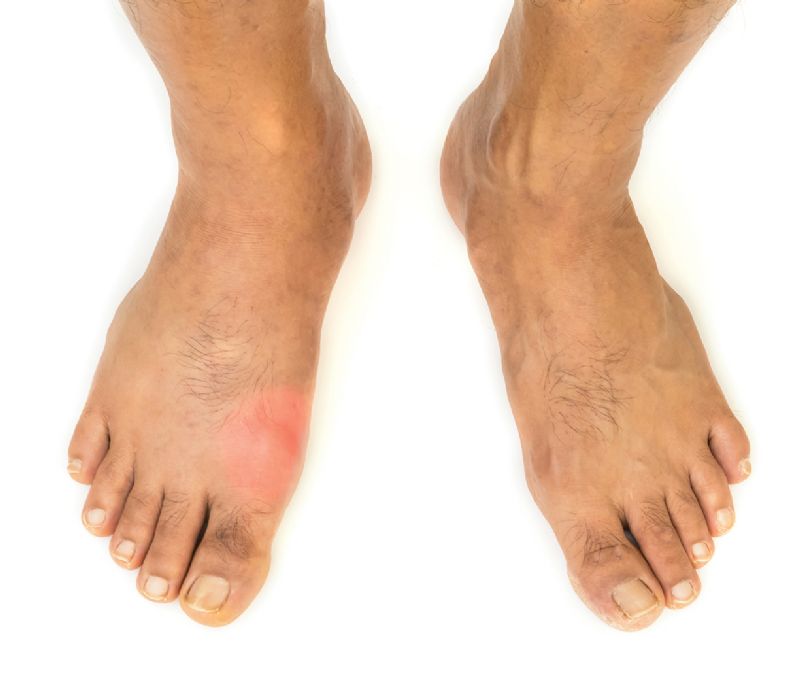- Home
- News, Articles & Reviews
- All Health & Beauty
- Looking Good, Feeling Great
- Medical Health
- Mirror Mirror on the Wall
- Style & Fashion
- General
- Vintage & Sustainable Fashion
We are hiring! Please click here to join our growing magazine delivery team in Gloucestershire!
Areas
Health & Beauty
Archive

Grappling with gout
All Areas > Health & Beauty > Medical Health
Author: Kirsty Lilley, Posted: Monday, 30th October 2023, 09:00
Gout is the most common type of inflammatory arthritis. It is caused by high levels of uric acid, which accumulate in the blood from the breakdown of purines.
These are natural chemicals found in each cell of the body and in many foods, especially red meat, certain sea foods, red wine and beer. When uric acid builds up it can form needle-like crystals that lodge in the joints and cause sudden, severe pain and swelling.
Gout is three times more likely to impact men than women. It usually affects men over the age of forty, and women can be more at risk after the menopause when they lose the protective effects of oestrogen.
Attacks of gout usually peak after 12 to 24 hours and then slowly recede. They very often develop in the joints of the big toe, but can occur in other joints including feet, hands, wrists, ankles and elbows. Recurrent attacks that aren’t treated may involve more joints, last longer and become increasingly severe over time.
Risk factors
You are more likely to develop gout if you:
• Eat lots of purine-rich foods such as those listed above.
• Consumer food and drink with high levels of artificial sweeteners or alcohol.
• Are overweight. This leads to your body producing higher levels of uric acid.
• Have a family history.
• Take high blood pressure medication.
• Have an imbalance in the gut microbiome, which regulates the immune system.
Diagnosing gout
If you are concerned that you are experiencing gout or any of the symptoms above, visit your GP to diagnose gout or rule out other conditions. Tests might include joint fluid analysis in which a sample of fluid is taken from the affected joint and checked for uric acid crystals.
Other tests include a blood test to check for uric acid levels and imaging tests such as x-rays and ultrasound, which can also detect uric acid levels in the blood.
Treatments
Working together with your GP, a treatment plan can be developed which is matched to your needs and might include the following:
• Lifestyle changes that could include changing your diet to reduce levels of purine-rich foods, eating a low salt diet, reducing levels of alcohol, and keeping weight within healthy levels.
• Anti-inflammatory medications which might include ibuprofen and naproxen. Please check for contraindications. Other medications available only on prescription include colchicine and corticosteroids.
• Uric acid lowering drugs including allopurinol, which are prescription-only.
Stigma and mental health
Over the centuries, gout has been associated with ‘excess’ and overindulgence, and it has been the butt of innumerable jokes. This stigma can prevent people from reaching out for help and, like other forms of arthritis, gout can often be associated with an increased risk of low mood and depression.
Reach out for help if you are concerned and don’t be embarrassed to speak with your GP and gain support from family and friends. Remember that regular exercise, a healthy diet and restorative sleep can go a long way to improving your mood and helping to manage the impacts of gout.Copyright © 2025 The Local Answer Limited.
Unauthorized use and/or duplication of this material without express and written permission from this site's author and/or owner is strictly prohibited. Excerpts and links may be used, provided that full and clear credit is given to The Local Answer Limited and thelocalanswer.co.uk with appropriate and specific direction to the original content.More articles you may be interested in...


© 2025 The Local Answer Limited - Registered in England and Wales - Company No. 06929408
Unit H, Churchill Industrial Estate, Churchill Road, Leckhampton, Cheltenham, GL53 7EG - VAT Registration No. 975613000You are leaving the TLA website...
You are now leaving the TLA website and are going to a website that is not operated by us. The Local Answer are not responsible for the content or availability of linked sites, and cannot accept liability if the linked site has been compromised and contains unsuitable images or other content. If you wish to proceed, please click the "Continue" button below:




